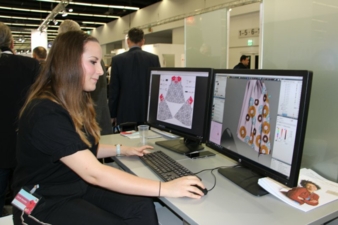01/02/2018 – Microfactory - part 2 — auf Deutsch lesen
The Worksteps - Step 1: Design
One of the biggest advantages of the Microfactory is its orientation on the customer and the customer’s wishes.
The garment is completely customized in accordance with the customer’s wishes. Thanks to a 3D simulation, the customer sees a photo-realistic image of the garment, which can be examined from all sides – and if the customer approves, production can start right there and then.
The first step for the apparel industry in the Microfactory is the garment’s individual design on the computer. Time for Vidya to be put into action! Fabric textures by Mitwill are already stored on this 3D simulation software by Assyst and a wide range of colors, patterns and additional prints are available. An on-site designer then helps to design the chosen garment in accordance with the wishes of the customer. They can experiment together with cut, color, patterning and printing, display color and pattern variations in seconds and view the garment from all angles. Details can also be zoomed in.
The customer immediately gets a realistic impression
“The advantage of 3D design is that the customer immediately gets a realistic impression of what his shirt etc. will look like,” says Sarah Kienzler, who was working with the Microfactory design team at the Texprocess. “We have a selection of the fabrics for printing ready to be handled by customers on site. The customer is right there on the scene and gets a first-hand impression of how his shirt is being made – he feels like he’s part of the production process, so the garment actually becomes a high-value item in his eyes.” The processes remain digital until the customer is satisfied. Then, with just a few clicks, the cut marks and QR codes are created. These are important for the downstream process, because they enable the cutter to identify the pattern pieces.
From 3D to 2D
A garment that’s designed in 3D has the identical visual appearance in 2D, just a short time after production – and this is mainly down to the color management of Caddon, a company that specializes in color and printing. Caddon’s technology enables color samples of fabrics to be captured multispectrally. The metrological proof and the visually color-correct imagery form an inseparable unit that cannot be manipulated. “Our technology stops all the time-consuming discussions about exact color values, because we combine the visual impression with exact measurements, pixel by pixel, irrespective of the fabric,” says Caddon’s Michael Nothelfer.




